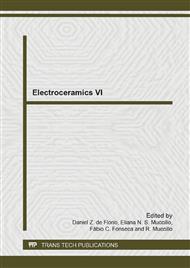[1]
J. Lettieri, M.A. Zurbuchen, Y. Jia, D. G. Schlom, S.K. Streiffer, M.E. Hawley, Epitaxial growth of non-c-oriented SrBi2Nb2O9 on (111) SrTiO3, Appl. Phys. Lett. 76 (2000) 2937.
DOI: 10.1063/1.126522
Google Scholar
[2]
R.C. Turner, P.A. Fuierer, R.E. Newnham, T.R. Shrout, Materials for high temperature acoustic and vibration sensors: A review, Appl. Acoust. 41 (1994) 299-324.
DOI: 10.1016/0003-682x(94)90091-4
Google Scholar
[3]
H. Yan, H.T. Zhang, R. Ubic, M.J. Reece, J. Liu, Z.J. Shen, Z. Zhang, A Lead-Free High-Curie-Point Ferroelectric Ceramic, CaBi2Nb2O9, Adv. Mater. 17 (2005) 1261-1265.
DOI: 10.1002/adma.200401860
Google Scholar
[4]
T. Takenaka, K. Sakata, Grain orientation effects on electrical properties of bismuth layer-structured ferroelectric Pb(1-x)(NaCe)x/2Bi4Ti4O15 solid solution, J. Appl. Phys. 55 (1984) 1092.
DOI: 10.1063/1.333198
Google Scholar
[5]
E.C. Subbrarao, Crystal Chemistry of Mixed Bismuth Oxides with Layer-Type Structure, J. Am. Ceram. Soc. 45 (1962) 166-169.
Google Scholar
[6]
R.E. Newnham, R.W. Wolfe, J.F. Dorrian, Structure basis of ferroelectricity in the bismuth titanate family, Mater. Res. Bull. 6 (1971) 1029-1039.
DOI: 10.1016/0025-5408(71)90082-1
Google Scholar
[7]
B. Jimenez, P. Duran-Martin, A. Castro, P. Millan, Obtention and characterization of modified Bi2SrNb2O9 Aurivillius-type ceramics, Ferroelectrics 186 (1996) 93-96.
DOI: 10.1080/00150199608218041
Google Scholar
[8]
P. Duran-Martin, A. Castro, O. Millan, B Jimenez, Influence of Bi-site Substitution on the Ferroelectricity of the Aurivillius Compounds Bi2SrNb2O9, J. Mater. Res. 13 (1998) 2565-2571.
Google Scholar
[9]
S.M. Huang, C.D. Feng, L.D. Chen, X.W. Wen, Dielectric properties of SrBi2-xPrxNb2O9 ceramics (x=0, 0. 04 and 0. 2), Solid State Comm. 133 (2005) 375-379.
DOI: 10.1016/j.ssc.2004.11.031
Google Scholar
[10]
H. naceur, A. Megriche, M.E. Maaoui, Structure distortion and dielectric properties of Sr1-x(Na0. 5Bi0. 5)xBi2Nb2O9 (x=0. 0, 0. 2, 0. 5, 0. 8 and 1. 0), J. Alloys Compd. 546 (2013) 145-150.
DOI: 10.1016/j.jallcom.2012.08.101
Google Scholar
[11]
Z.H. Peng, Q. Chen, J.G. Wu, X.H. Zhu, D.Q. Xiao, J.G. Zhu, Dielectric and piezoelectric properties of Sb5+ doped (NaBi)0. 38(LiCe)0. 05[]0. 14Bi2Nb2O9 ceramics, J. Alloys Compd. 509 (2011) 8483-8486.
DOI: 10.1016/j.jallcom.2011.06.024
Google Scholar
[12]
Z.G. Gai, J.F. Wang, C.M. Wang, Effect of (Li, Ce) doping in Aurivillius phase material Na0. 25K0. 25Bi2. 5Nb2O9, Appl. Phys. Lett. 90 (2007) 052911.
DOI: 10.1063/1.2450669
Google Scholar
[13]
J.J. Zhang, M.J. Chao, E.J. Liang, M.Y. Li, Synthesis and dielectric properties of textured SrBi2Nb2O9 ceramics via laser rapid solidification, J. Alloys Compd. 521 (2012) 150-154.
DOI: 10.1016/j.jallcom.2012.01.099
Google Scholar
[14]
P.Y. Fang, H.Q. Fan, J. Li, F.J. Liang, Lanthanum induced larger polarization and dielectric relaxation in Aurivillius phase SrBi2-xLaxNb2O9 ferroelectric ceramics, J. Appl. Phys. 107 (2010) 064104.
DOI: 10.1063/1.3340981
Google Scholar
[15]
Y. Yao, C. Song, P. Bao, D. Su, X. Lu, J. Zhu, Y. Wang, Doping effect on the dielectric property in bismuth titanate, J. Appl. Phys. 95 (2004) 3126.
DOI: 10.1063/1.1649456
Google Scholar
[16]
B.H. Venkataraman, K.B.R. Varma, Frequency-dependent dielectric characteristics of ferroelectric SrBi2Nb2O9 ceramics, Solid State Ionics 167 (2004) 197-202.
DOI: 10.1016/j.ssi.2003.12.020
Google Scholar
[17]
Y. Ding, J.S. Zhu, Y.N. Wang, Stacking faults and their effects on ferroelectric properties in strontium bismuth tantalate, J. Appl. Phys. 91 (2002) 2255.
DOI: 10.1063/1.1431428
Google Scholar
[18]
B.J. Kalaiselvi, R. Sridarane, Ramaswamy Murugan, Dielectric properties of Sr0. 8Bi2. 2(V0. 2Nb0. 8)2O9 ceramic, Mater. Sci. Eng. B 127 (2006) 224-227.
DOI: 10.1016/j.mseb.2005.10.028
Google Scholar
[19]
K. Uchino, S. Nomura, Ferroelectr. Lett. Sect. 44 (1982) 55.
Google Scholar
[20]
S.M. Ke, H.Q. Fan, H.T. Huang, H.L.W. Chan, S.H. Yu, Dielectric dispersion behavior of Ba(ZrxTi1-x)O3 solid solutions with a quasiferroelectric state, J. Appl. Phys. 104 (2008) 034108.
DOI: 10.1063/1.2964088
Google Scholar


